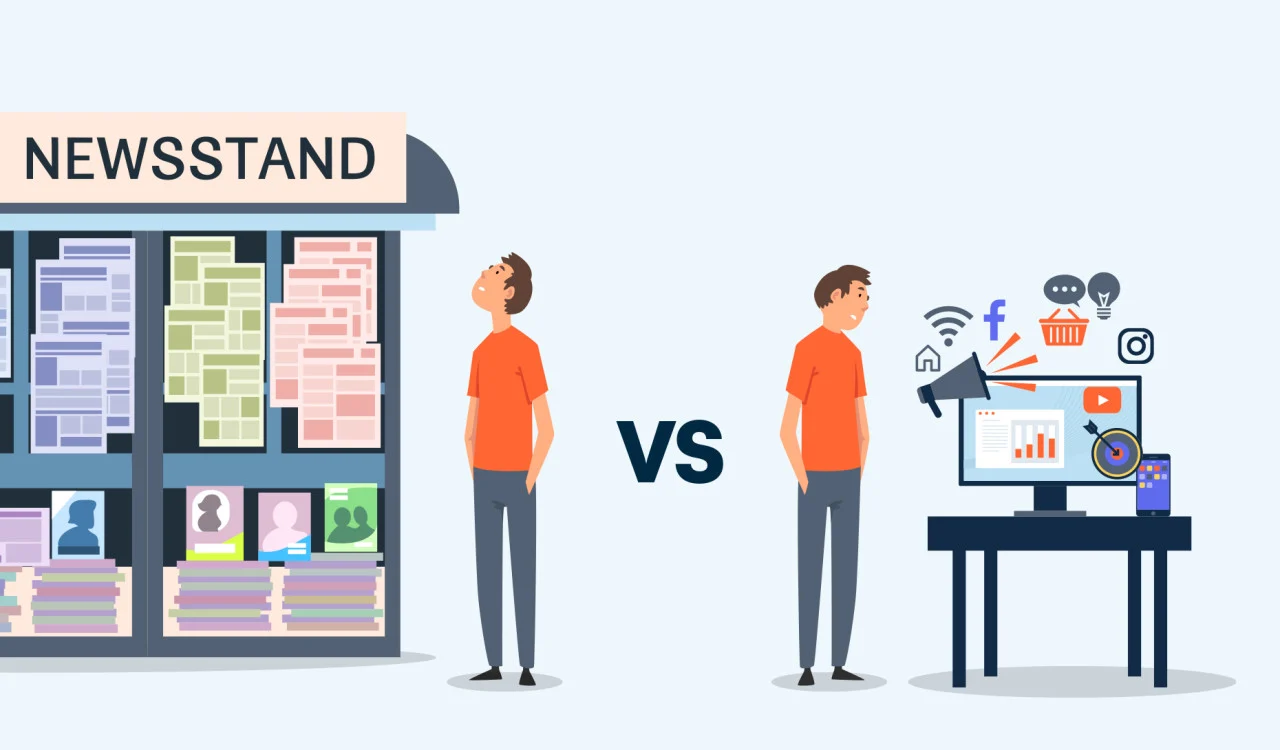
Advertising Online vs Traditional Advertising: Which Works Better?
- Alex
- 0
- Posted on
Walk down any city street, and you’ll still see bright billboards, posters, and flyers competing for your attention. But as soon as you glance at your smartphone, another world of marketing opens up—sponsored posts, video ads, search results, and pop-ups designed just for you. The debate between advertising online and traditional advertising isn’t just about where ads appear; it’s about how audiences connect, respond, and make purchasing decisions.
As technology and consumer behavior continue to evolve, the question has become more relevant than ever: which method truly works better—digital or traditional? Let’s explore how each type functions, their pros and cons, and what makes advertising online stand out in the marketing mix of 2025.
Understanding Traditional Advertising
Traditional advertising refers to the classic methods that dominated marketing for decades—TV and radio commercials, newspaper and magazine ads, billboards, flyers, and direct mail. These channels reach broad audiences and rely on visual and emotional appeal to create brand awareness.
For many years, traditional advertising was the gold standard. Big brands spent millions on TV slots during prime time or printed full-page spreads in national newspapers. This approach was less about precision targeting and more about mass exposure—getting as many eyeballs on an ad as possible.
However, the way people consume media has changed dramatically. The rise of streaming platforms, online news, and social media has fragmented audiences. Fewer people are watching traditional TV or flipping through printed magazines. As a result, while traditional ads still have influence, they don’t command the same universal reach they once did.
What Is Advertising Online?
Advertising online refers to promoting products or services through internet-based platforms such as search engines, websites, social media networks, email campaigns, and streaming platforms. Unlike traditional methods, digital advertising offers a high level of precision and measurable results.
This form of marketing uses data analytics, targeting algorithms, and artificial intelligence to deliver personalized messages directly to the right people. Whether through search engine marketing (like Google Ads), sponsored Instagram posts, YouTube videos, or influencer partnerships, advertising online helps brands connect with audiences in ways that feel relevant and immediate.
Online advertising also offers flexibility—businesses can start small, adjust their strategies in real time, and scale up based on performance. That’s a game-changer compared to the fixed costs and slower turnaround times of traditional campaigns.
Comparing the Two Approaches
1. Reach and Targeting
Traditional advertising casts a wide net, making it great for building general brand awareness. For instance, a national TV ad can reach millions of households at once. However, it can’t distinguish between potential customers and those who aren’t interested.
Advertising online, on the other hand, excels in targeting. Digital platforms collect data about users’ age, location, interests, behavior, and even online shopping habits. This allows advertisers to reach exactly who they want, ensuring every dollar spent goes toward a relevant audience. A local bakery, for example, can run Facebook ads targeting people within a five-mile radius who love pastries or coffee—a level of precision that traditional media can’t match.
2. Cost Efficiency
Traditional advertising often comes with high upfront costs. A single TV commercial or a billboard in a prime location can cost thousands or even millions of dollars, depending on the campaign’s scale. Smaller businesses may find these barriers difficult to overcome.
Advertising online is far more cost-effective and accessible. Platforms like Google Ads or social media allow advertisers to set their own budgets and pay only when someone interacts with their ad (pay-per-click). This makes digital advertising ideal for startups, freelancers, and small businesses that need measurable results without breaking the bank.
3. Measurability and Analytics
One of the biggest drawbacks of traditional advertising is that it’s difficult to measure results accurately. You might know how many people watch a TV channel or read a magazine, but there’s no precise way to track how many of them took action after seeing your ad.
By contrast, advertising online provides detailed analytics in real time. You can see how many people clicked your ad, visited your website, or made a purchase. This data-driven insight allows businesses to refine their strategies, allocate budgets wisely, and achieve higher returns on investment (ROI).
4. Engagement and Interaction
Traditional ads are one-way communication. They deliver a message but don’t encourage immediate feedback. Audiences can’t interact with a billboard or magazine page.
Online advertising thrives on engagement. Users can like, share, comment, or click through to learn more. Brands can respond instantly, creating real conversations with their audiences. This interactivity fosters stronger relationships and brand loyalty.
5. Lifespan and Flexibility
A traditional ad, once published or aired, is fixed. If there’s an error or the message needs updating, it often requires producing and paying for a new version.
With advertising online, campaigns can be adjusted instantly. Marketers can test multiple ad variations (A/B testing), pause underperforming ads, and reallocate budgets in real time. The ability to adapt on the fly makes digital campaigns more dynamic and responsive.
Where Traditional Advertising Still Shines
Despite the dominance of digital, traditional advertising hasn’t become obsolete. It still plays a crucial role in brand visibility—especially for large-scale campaigns and local outreach.
For example, TV ads during major sporting events or movie premieres can create a strong emotional connection with viewers. Outdoor billboards remain effective in high-traffic areas, reinforcing brand recognition. Print ads in niche magazines can target specialized audiences like luxury consumers or hobby enthusiasts.
Traditional advertising also carries a sense of credibility and trust. Seeing a brand in print or on television can give it a sense of legitimacy that online ads sometimes struggle to achieve, especially with issues like ad fraud or misinformation online.
The Verdict: Which Works Better?
There’s no one-size-fits-all answer. The effectiveness of each method depends on a brand’s goals, target audience, and budget. However, for most businesses in 2025, advertising online holds a clear edge due to its affordability, precision targeting, and measurable outcomes.
That said, the smartest marketing strategies combine both approaches. A blended strategy—such as running social media ads to support a traditional TV campaign—creates a more cohesive customer experience. This omnichannel approach ensures that audiences encounter the brand across multiple touchpoints, reinforcing awareness and trust.
Conclusion
The marketing world has shifted dramatically, but the core goal remains the same: reaching people with the right message at the right time. Traditional methods still hold emotional power, but advertising online offers unmatched control, insight, and flexibility.
For brands seeking measurable impact and meaningful engagement, online advertising isn’t just the future—it’s the present. Yet, the real magic happens when businesses harness the strengths of both digital and traditional channels, blending timeless storytelling with modern precision to create campaigns that truly connect and convert.
